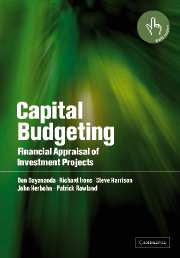Book contents
- Frontmatter
- Contents
- List of figures
- List of tables
- Preface
- 1 Capital budgeting: an overview
- 2 Project cash flows
- 3 Forecasting cash flows: quantitative techniques and routes
- 4 Forecasting cash flows: qualitative or judgemental techniques
- 5 Essential formulae in project appraisal
- 6 Project analysis under certainty
- 7 Project analysis under risk
- 8 Sensitivity and break-even analysis
- 9 Simulation concepts and methods
- 10 Case study in financial modelling and simulation of a forestry investment
- 11 Resource constraints and linear programming
- 12 More advanced linear programming concepts and methods
- 13 Financial modelling case study in forestry project evaluation
- 14 Property investment analysis
- 15 Forecasting and analysing risks in property investments
- 16 Multinational corporations and international project appraisal
- References
- Index
9 - Simulation concepts and methods
Published online by Cambridge University Press: 14 May 2010
- Frontmatter
- Contents
- List of figures
- List of tables
- Preface
- 1 Capital budgeting: an overview
- 2 Project cash flows
- 3 Forecasting cash flows: quantitative techniques and routes
- 4 Forecasting cash flows: qualitative or judgemental techniques
- 5 Essential formulae in project appraisal
- 6 Project analysis under certainty
- 7 Project analysis under risk
- 8 Sensitivity and break-even analysis
- 9 Simulation concepts and methods
- 10 Case study in financial modelling and simulation of a forestry investment
- 11 Resource constraints and linear programming
- 12 More advanced linear programming concepts and methods
- 13 Financial modelling case study in forestry project evaluation
- 14 Property investment analysis
- 15 Forecasting and analysing risks in property investments
- 16 Multinational corporations and international project appraisal
- References
- Index
Summary
The term ‘simulation’ is widely used nowadays, and most people have their own view of its meaning. In general, to ‘simulate’ means to mimic or capture the essence of something, without attaining reality. In management applications, simulation typically involves developing a model of a business or economic system, and then performing experiments using this model to predict how the real system would behave under a range of management policies. In that financial models have been used repeatedly in earlier chapters, the importance of modelling will come as no surprise here. But when discussing simulation, attention to aspects of modelling becomes even more important since simulation models are often highly complex representations of business systems.
While many quantitative techniques take a well-recognized form, simulation differs in its great flexibility, variety of applications and variations in form. These features, while highly valuable for modelling complex business systems, make this a difficult methodology to explain and to comprehend. In fact, simulation has been described as ‘more art than science’. Proficiency with this technique cannot readily be gained in the classroom. Considerable hands-on experience from repeatedly designing, developing and performing experiments with a number of different models is also necessary. But even for readers who will not be engaged in developing complex models, an understanding of simulation concepts is indispensable because of the widespread use of this methodology.
The financial models encountered in earlier chapters, typically developed on a spread-sheet, may be regarded as a form of simulation.
- Type
- Chapter
- Information
- Capital BudgetingFinancial Appraisal of Investment Projects, pp. 153 - 184Publisher: Cambridge University PressPrint publication year: 2002



